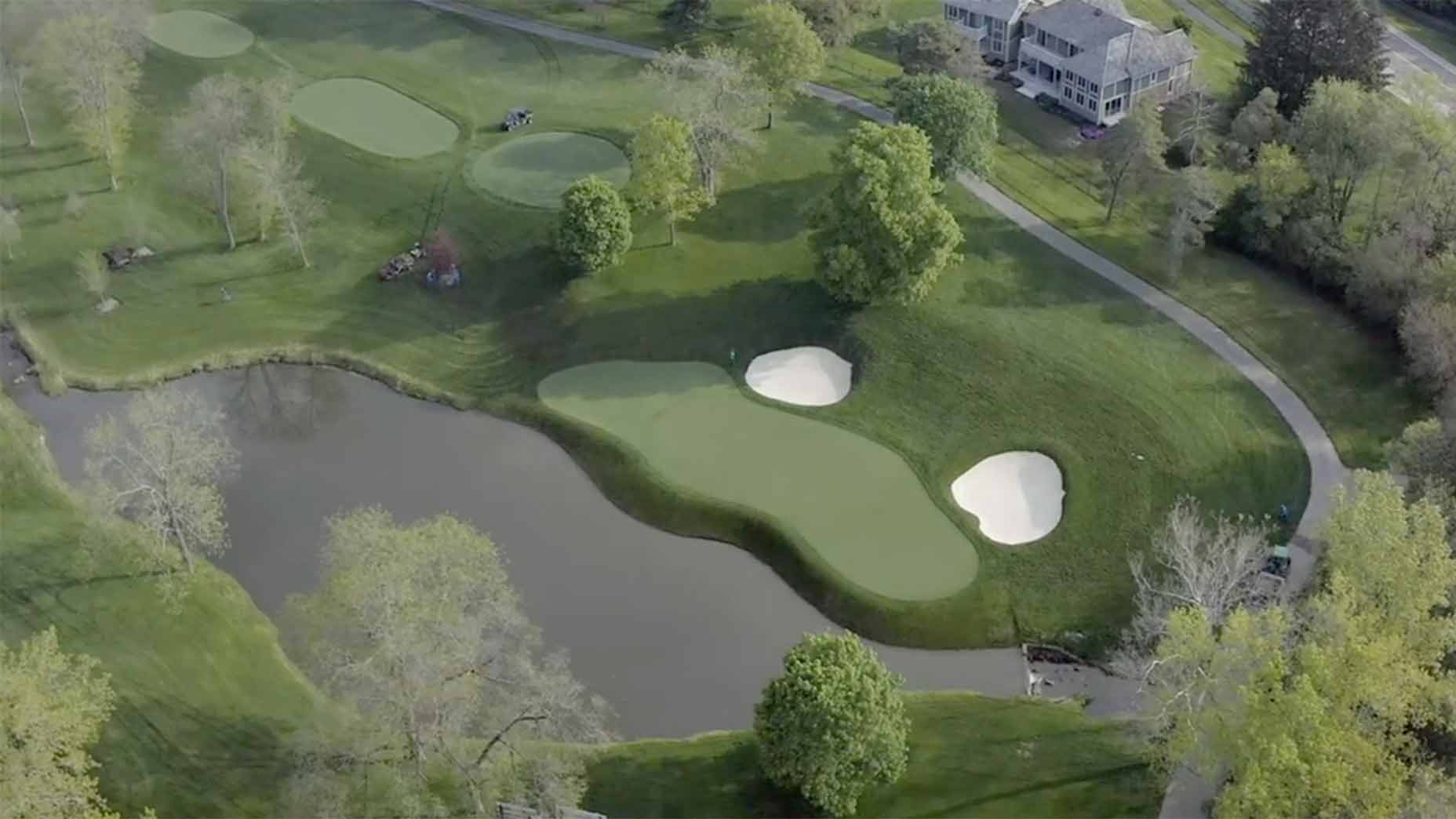The Dream 18. It has a nice ring to it, doesn’t it? We thought so, too. Earlier this summer, GOLF unveiled its first-ever Top 100 Courses in the UK and Ireland ranking, a list that honored some of the best, most well-known courses in the world, but also rightfully highlighted some unknown gems you could play at a bargain price.
That’s the beauty of golf overseas. Accessible. Affordable. Fun. Quirky. We could go on and on. But to go one step further, we wanted to make a list within out list, one that would circle the best of the best when it comes to some of the top courses in the world.
So here’s the deal. Exclusive for our InsideGOLF members, we tasked GOLF architecture editor Ran Morrissett with coming up with the best 18 holes among the 100 courses on the ranking, and he did one better: he even kept the list true to hole numbers. For example, the ninth hole on our list is actually the 9th hole at that specific course.
No course was listed twice, and this par-72 routing has 10 par-4s, four par-3s and four par-5s, and each nine has two par-3s and two par-5s.
So, without further ado, we present you with the Dream 18 of our Top 100 Courses in the UK and Ireland ranking. Start salivating.
No. 1 / Machrihanish, 425 yards, par-4
We get our Dream 18 underway in the most breathtaking manner possible. Picture a small pro shop, a tee along a cliff, the Atlantic waters some 20 feet below and a beach ahead that you must carry as the fairway swings left and heads up the shore. This opener is one of – some say THEE – greatest diagonal tee shot in the game and dates back to Old Tom Morris in 1879. Alister MacKenzie was a frequent visitor to this links and no doubt was impressed by the roly-poly nature of the 1st green, which kickstarts one of the game’s great sets of green complexes.
No. 2 / Huntercombe, 420 yards, par-4
This Willie Park Jr. design west of London is famous for its paucity of bunkers with this bunkerless hole being a prime example. At the second, Park beautifully exploits the long broad right-to-left slope of the English countryside, both on the tee ball and approach. Should you aim 1, 5 or 10 yards right of the green and watch the ball trundle down onto the open putting surface? By posing such interesting ground game questions, Park showed (in 1901!) how an inland course could require as much imagination to play as a links.

No. 3 / Prestwick, 535 yards, par-5
The merit of a central bunker can’t be overstated on par-5 holes. Be it Hell Bunker at St. Andrews or the Saraha bunkers that Tillinghast routinely deployed at places like Baltusrol and Baltimore CC, the ask is a timeless one: the player must get his tee ball in play to cross a fierce hazard to have a pitch left to a green. Here, the sleepered Cardinal bunker that slashes across the fairway 160 yards from the green is as formidable as a hazard gets.
No. 4 / Woking, 350 yards, par-4
Woking has long been a think-tank for design. Stuart Patton had the wisdom to insert two bunkers akin to the Principal’s Nose at 16 at St. Andrews into the left middle of Tom Dunn’s fairway, exactly where drives like to finish. At the green, he inserted a left bunker and had the green angle from front right to back left. Does the golfer have the guts to hit between the fairway bunkers and the railroad line down the right? If so, he enjoys a fine angle with a short iron into the green. Member Tom Simpson sat up on the hillside behind the tee and marveled for hours on how the central hazard combined with the angle of the green made this a strategic marvel. Simpson went on to contribute mightily to golf course architecture at places like Morfontaine, Ballybunion and Cruden Bay.

No. 5 / Royal Worlington & Newmarket, 160 yards, par-3
Yard for yard, this might be the most taxing shot on our Dream 18. It doesn’t need length, rather it relies on the cunningness of the architect to have draped the long, narrow green on a ridge. Miss it left and the ball peels away into a hollow known as Mog’s Bog and miss it right and the ball is shunted toward a creek. The origin of the expression “the world’s shortest par-5” is murky but applies here!
No. 6 / Cruden Bay, 530 yards, par-5
Par-5s built 100-plus years ago are under siege from advancements in technology, essentially needing to rely on a spiffy green complex to keep the barbarians at the gate. That’s what we find here and this hole actually woos you to go for it in two, which is when the fireworks begin. A burn crosses the width of the fairway just short of the green and the bank of the burn is 15 feet high on the direct line to the green after a big tee ball. Being short is obviously no good nor is long, as the putting surface is severely tilted from back to front. Being prudent is often the better part of valor, thanks to this testy green complex.

No. 7 / Pennard, 350 yards, par-4
Though the 12th century ruin of Pennard Castle is a mere 80 yards to the right of the green, the eye is nonetheless drawn straightaway to one of the game’s lumpiest fairways. Where a tee ball may ricochet to is in the lap of the Gods — just hope it isn’t into a small pit 60 yards short of the green. Extraction from this menace of a bunker in one shot is far from guaranteed, given its near vertical bunker face. The green mimics the fairway with lots of undulations with an upper-left shelf providing the most difficult hole locations. Pure Welsh magic with the Bristol Channel serving as the backdrop.
No. 8 / St. George’s Hill, 180 yards, par-3
No one has ever been better at effortlessly incorporating a shallow valley into the design of a par-3 than Harry Colt. Outstanding examples abound around London. This oft-photographed one is especially gratifying, thanks to its downhill nature that allows you to see your shot play out in full and the satisfaction derived from having your tee ball pass beyond the severe fronting hazards prior to the green.

No. 9 / Lahinch, 400 yards, par-4
Alister MacKenzie made dramatic changes when he worked at Lahinch in the 1920s. The piece-de-resistance might be this 55-yard deep but narrow shelf green. The land forms shunt your tee ball to the left while this green begs for an approach from the high right side. The sloping fairway insists on putting the ball above the right hander’s feet and the resultant draw is likely not the desired outcome as the golfer soon finds himself in a grassy hollow well below the putting surface. The need to make fiddly adjustments to your stance and setup is a major underpinning to the allure of links golf.
No. 10 / Ardfin, 175 yards, par-3
Australian architect Bob Harrison was careful to make the holes at Ardfin play well in all winds, which routinely occur in the Inner Hebrides on the Isle of Jura. Run-up options abound on virtually every hole – but here. Indeed, the only rule in design is that rules are meant to be broken. The tees are along a cliff, followed by a rock strewn pocket complete with canyons left from centuries of coastal erosion, and the green on the far side. The forced carry is – by definition – uncompromising but this one is so epic, its setting along the waterway that separates Jura and Islay so stunning, that the hole simply had to be built. Unseen from the tee, Harrison provides a short grass bailout area right of the green but for those brave enough to successfully take the direct line, the adrenaline rush has few equals in golf.

No. 11 / Royal North Devon, 395 yards, par-4
A variety of hazards lend a course its own unmistakable identity. Westward Ho! (as the course is often referred) throws a lot at the golfer, including the Great Sea Rushes at Nos. 10-12. They can impale most objects so to say they are some of the game’s most feared hazards is no exaggeration! At the 11th, they border both the left and right sides of the fairway, making the tee ball one of the nerviest on these ancient links. Great to see a sub-400 yarder cause such consternation; every course needs a true positional hole like this one.
No. 12 / Sunningdale Old, 440 yards, par-4
It took two design titans to end up with this hole. First, Willie Park Jr. laid out the original playing corridor and then Harry Colt later moved the green 70 yards up and to the left to its current commanding position. This hole enjoys an exalted standing in architecture and so impressed C.B. Macdonald that he patterned his Bottle hole designs after it.

No. 13 / Royal County Down, 445 yards, par-4
The front at County Down is widely considered to be the finest first nine in golf. Yet, for many, the course’s best hole is this banana shaped one that runs through a valley between two dunes. Golfer A may try to drive it left and as far down the valley as possible as the green potentially comes into view around the bend for one’s second. Golfer B may lay back a bit on the right, before hoisting a blind approach up and over a bank of gorse and heather toward the white and black directional marker. Happily, shots can kick in from the right as there is plenty of short grass that feeds onto the open putting surface. Hard to beat a hole that looks and acts tough but that also gives you room to play.
No. 14 / St. Andrews Old Course, 560 yards, par-5
“Option-filled” is an overused phrase in golf but no other phrase is more apt for describing this one. There are more than a dozen ways to plan your way through this long three-shotter. It likely starts by landing your tee ball in the comparatively flat Elysian Fields, and then the golfer debates any number of potential shots, including how to handle Hell Bunker. Even if all goes well, its plateau green acts as a final defense, shedding balls off in every which direction.

No. 15 / Ballybunion Old, 210 yards, par-3
If one view best captures the allure of golf in a foreign country, it is this one standing on the 15th tee at Ballybunion. From its elevated tee, the golfer enjoys an exhilarating view of the two-tiered green in the distance, nestled among dunes with the pounding Atlantic surf just behind. The heart sings as this is man vs. nature at her most unfiltered, dramatic best.
No. 16 / North Berwick, 380 yards, par-4
The game’s most copied hole (The Redan) precedes this one and hogs the spotlight but this hole might possess the single most confounding green in links golf. It plays like a Biarritz green in the sense that the green consists of two plateaus with a valley separating them, cocked at a 45-degree angle to the fairway. Figuring out how to get your ball to stop on the hump that houses the day’s hole location is one of those magic moments where you wish you had a small satchel of balls and could just keep hitting the approach until you get it right.

No. 17 / Brora, 430 yards, par-4
This stout two-shotter follows in the footsteps of the Road Hole in that having the course’s toughest par as the penultimate hole often makes for a thrilling conclusion. Without doubt, this is Brora’s hardest hole thanks to fescue covered in the middle of the fairway. Which way you steer from it is wind dependent, so the ask off the tee shot changes on a daily basis. The high right side allows you to hit an approach from level with the green, albeit from a sloping lie. The safer, lower left side of the fairway is more level but a left-front greenside bunker now becomes problematic. Don’t miss this James Braid course when next in Scotland; some consider it his finest design.
No. 18 / Castle Stuart, 590 yards, par-5
The best finishing holes produce a wide range of outcomes while still leaving the golfer wanting more. This 1/2 hole fits that bill as well as any with its fairway tumbling downhill toward the distinctive white art deco clubhouse. Fifty-plus yards in roll out is commonplace downwind for tee balls and the question then becomes can the golfer carry the broken ground and reach the green in two? It’s an enticing proposition that beckons for return rounds. There is a safe path too in from the left, so golfers of all abilities derive pleasure in playing it.













